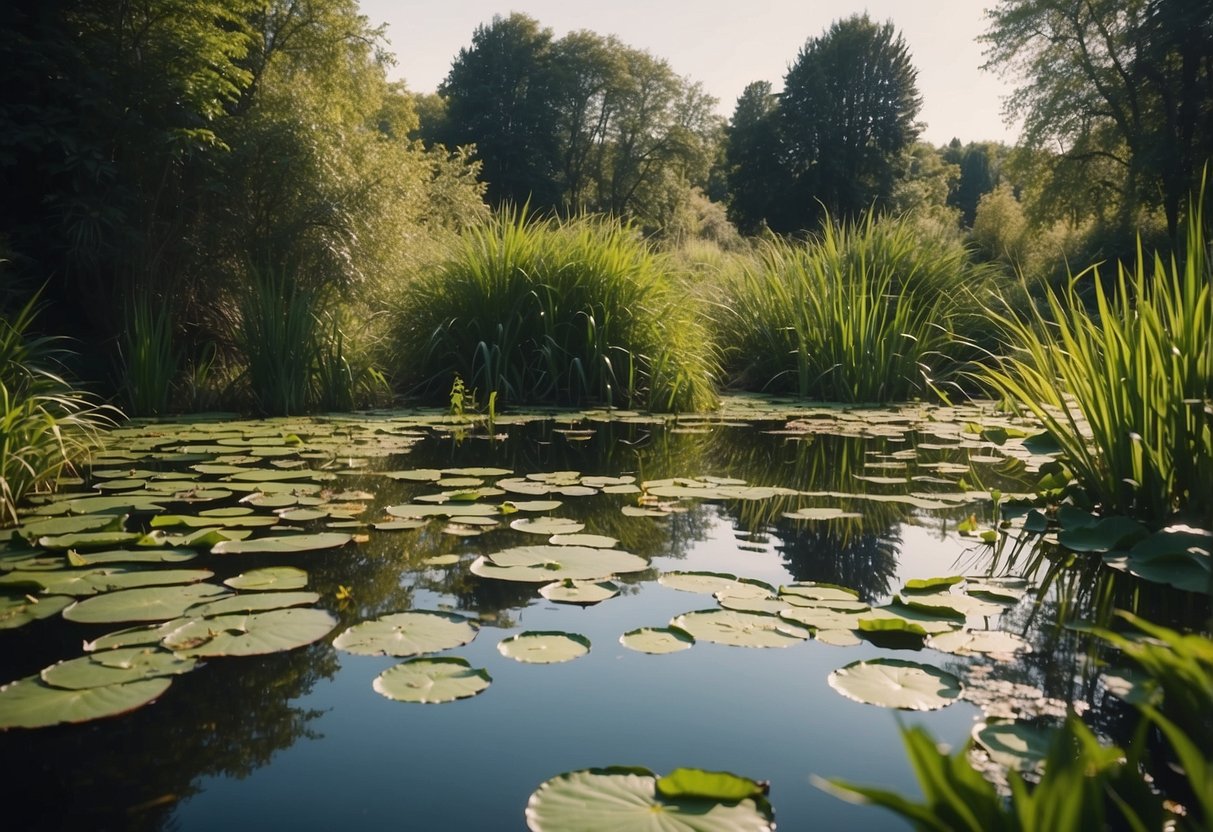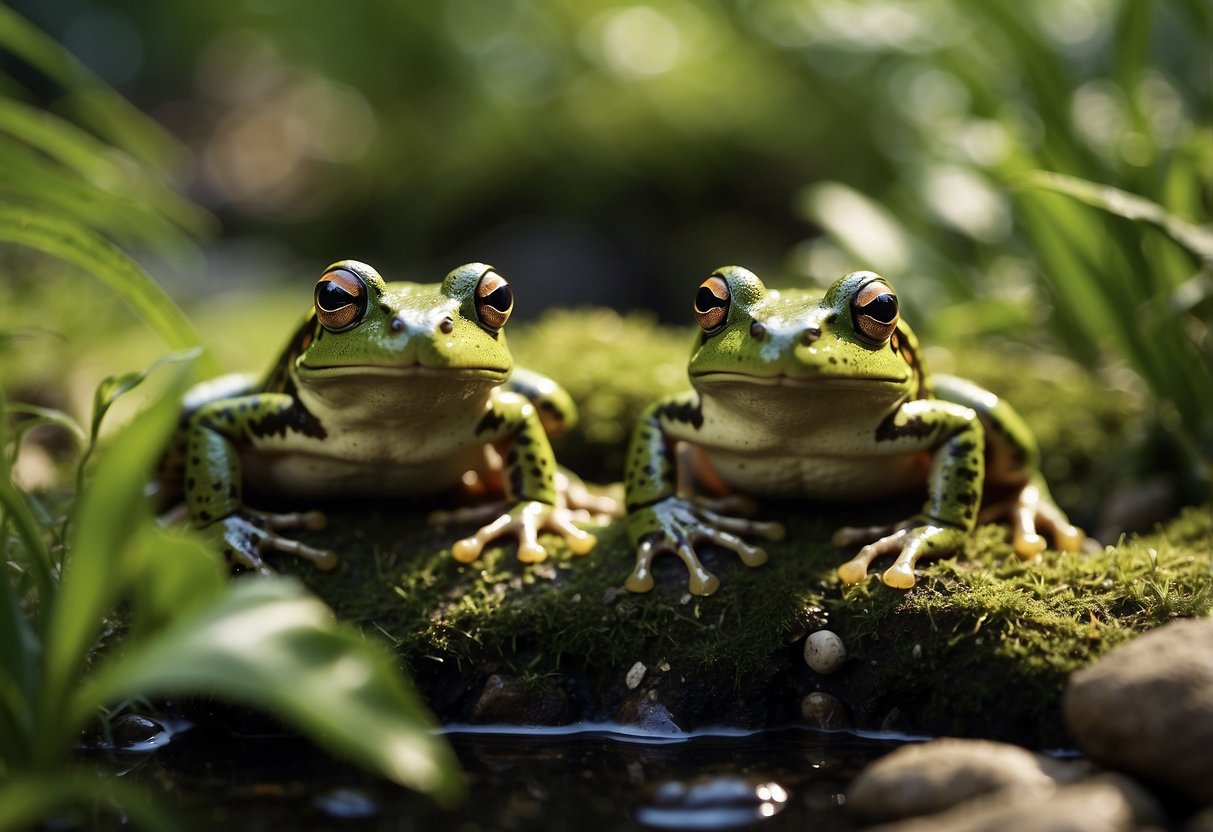Do I need a water feature to attract frogs and toads?
Essential elements for amphibian-friendly gardens
Frogs and toads can be great additions to any garden. They eat pests and add a natural charm to outdoor spaces.
Many people wonder if they need a water feature to attract these amphibians. The answer is not as simple as yes or no.

A water feature can help attract frogs and toads, but it’s not always necessary. These creatures are drawn to moist environments with plenty of hiding spots.
A small pond can be ideal, but it’s not the only option. Even a shallow dish of water can work in a pinch.
Creating a frog-friendly habitat is more important than having a large water feature. This means providing shelter, food sources, and some moisture.
A mix of plants, rocks, and logs can create the perfect environment for frogs and toads to thrive.
Key Takeaways
- Water features attract frogs but aren’t always needed
- Creating a moist environment with hiding spots is key
- A mix of plants and natural materials can provide a suitable habitat
Understanding Frog and Toad Habitat Preferences
Frogs and toads have specific habitat needs that influence where they live and thrive. These amphibians require a mix of water and land environments, with some key differences between species.
Natural Habitats of Frogs and Toads
Frogs typically live near water sources. I’ve observed them in ponds, lakes, streams, and wetlands. They have smooth, moist skin that needs to stay damp.
Toads are more land-based. I often spot them in gardens, forests, and fields. Their dry, warty skin helps them survive in drier places.
Both frogs and toads need:
- Places to hide from predators
- Food sources (insects, worms)
- Breeding areas
Frogs prefer warmer water (68-75°F) for their tadpoles. Toad tadpoles can handle cooler temperatures (50-68°F).
Factors Influencing Frog and Toad Habitats
Several factors affect where frogs and toads choose to live:
- Water availability
- Temperature
- Vegetation cover
- Food supply
- Predator presence
Frogs need constant access to water, so they prefer areas near water sources. Toads, on the other hand, can venture farther from water sources.
Climate plays a big role. Frogs and toads are cold-blooded, so they rely on their environment to regulate body temperature.
Vegetation is crucial for shelter and hunting. Dense plants near water bodies are ideal for frogs. Toads often hide under leaves or logs on land.
Human activity impacts their habitats too. Pollution and habitat loss can drive these amphibians away from areas they once called home.
Benefits of Water Features for Amphibians
Water features play a key role in attracting and supporting frogs and toads. They provide essential habitat for amphibian health and reproduction.
Water Quality and Amphibian Health
Clean water is vital for amphibian wellbeing. A garden pond or water feature gives frogs and toads a place to stay moist and cool. This helps them breathe through their skin.
I’ve found that using rainwater is best. Tap water can have chemicals that harm amphibians. If I must use tap water, I let it sit for a day to let chlorine evaporate.
Plants in and around the water help keep it clean. They also give frogs places to hide. I make sure to include some floating plants and submerged vegetation.
The Role of Water in Breeding Cycles
Water is crucial for frog and toad breeding. They lay their eggs in standing water. A small pond about 20 inches deep is ideal for many species.
I’ve seen that a mix of sun and shade works best. This creates warm spots for egg-laying and cool areas for adults.
Even a simple birdbath on the ground can help. It gives frogs a place to cool off and stay moist.
Tadpoles need water to grow into adults. A stable water source throughout spring and summer is key for their development.
Designing a Frog- and Toad-Friendly Water Feature
A well-designed water feature is key to attracting frogs and toads. I’ll explain how to create a safe and welcoming habitat with the right size, depth, and plants.
Suitable Dimensions and Depth for Safety
I recommend making a small pond about 20 inches deep in the center. This depth lets frogs dive to stay cool and hide from predators. The edges should slope gently so frogs can easily get in and out.
For size, even a small feature works. I suggest at least 3-4 feet across to give frogs room to swim. Bigger is better if you have the space.
Make sure to use clean, de-chlorinated water. If you use tap water, let it sit for 48 hours so the chlorine evaporates.
Vegetation and Shelter Considerations
Plants are crucial for a frog-friendly pond. I advise adding floating plants like water lilies to provide shade and cover. Submerged plants give tadpoles a place to hide.
Around the edges, plant tall grasses and ferns. These give adult frogs shelter and hunting spots.
Native plants are best as they attract insects frogs like to eat.
Add some rocks or logs near the water. Frogs use these to bask in the sun and as shelter. Make sure the area has both sunny and shaded spots to meet different frog needs.
Alternatives to Water Features

You can still attract frogs and toads without a pond or water feature. I’ll explain some effective alternatives that create suitable habitats and moisture for these amphibians.
Creating Damp Microhabitats
I recommend setting up damp areas in your yard to mimic natural frog habitats. Place shallow dishes or trays filled with water in shady spots. Change the water often to keep it clean.
Add logs, rocks, and plants near these water sources. This gives frogs places to hide and stay moist. Mulch piles and leaf litter also work well to hold moisture.
I suggest misting areas of your yard regularly with a hose. Focus on shady spots under shrubs or trees. This keeps the ground damp for frogs.
Landscaping for Frog and Toad Conservation
I find that certain plants help create frog-friendly spaces. Choose native species that thrive in moist conditions. Ferns, mosses, and wetland plants work great.
Create areas with tall grass and dense groundcover. This gives frogs cool, damp places to rest during the day.
Avoid using chemicals in your yard. Frogs absorb substances through their skin easily. I recommend natural pest control methods instead.
Add some flat rocks or pieces of wood as “toad abodes.” Place these in shady areas. Lift them occasionally to check for toads hiding underneath.
Maintaining Your Garden’s Ecosystem
Creating a frog-friendly garden involves more than just adding water. I’ll cover key aspects of maintaining a healthy ecosystem for amphibians, including pest management and seasonal care.
Pesticides and Their Impact on Amphibians
Pesticides can be harmful to frogs and toads. These chemicals can seep into their skin and affect their health.
To keep my garden frog-friendly, I avoid using harsh chemicals.
Instead, I opt for natural pest control methods. I plant native species that attract beneficial insects. These bugs help keep pests in check without harming amphibians.
I also encourage natural predators like birds and bats. They eat many of the same insects that frogs do, creating a balanced ecosystem.
Seasonal Considerations and Habitat Management
My frog habitat needs different care throughout the year.
In spring, I make sure there’s plenty of shallow water for breeding. I keep some areas of my garden damp and shaded for tadpoles to develop.
During summer, I maintain cool, moist areas. I do this by adding leaf litter and creating rock piles. These spots give frogs places to hide from the heat.
In fall, I leave some plant debris for winter shelter. I’m careful not to disturb these areas when cleaning up my garden.
Year-round, I keep a mix of ground cover, shrubs, and trees. This variety provides different layers of habitat for frogs at various life stages.
Community and Legal Considerations

Before adding water features to attract frogs and toads, I need to think about my neighbors and local laws.
Some people might not like having amphibians nearby. It’s a good idea to talk to my neighbors first.
I can explain the benefits of frogs and toads, like eating pests in the garden. This can help avoid conflicts later on.
I should check my local rules about water features. Some areas have limits on pond size or depth. There may also be rules about noise levels, which could affect frog calls at night.
If I live in a homeowners association, I’ll need to review their guidelines. Some HOAs have strict rules about landscaping changes.
Safety is important too. I’ll make sure any water features are secure, especially if there are young children in the area.
Frequently Asked Questions
Attracting frogs and toads to your garden doesn’t always require a water feature. There are many ways to create a welcoming habitat for these amphibians using alternative methods and environmental factors.
How can I attract toads to my garden without a water feature?
I’ve found that creating a toad house can be very effective. Use an upside-down clay pot with a small entrance. Place it in a shady spot near plants.
Add a shallow dish of water nearby for hydration. Keep the area around the toad house moist and cool.
What environmental factors will attract frogs to my backyard?
Frogs are drawn to areas with high humidity and shelter. I recommend planting dense vegetation and ground cover. Native plants work best.
Avoid using pesticides, as they harm frogs and their food sources. Create piles of leaves or logs for hiding spots.
Is it possible to have a toad-friendly garden without a pond?
Yes, it’s quite possible. I’ve seen success with creating damp areas using mulch or moss. Toads need moisture, but not necessarily standing water.
Provide hiding spots like rocks or fallen branches. Plant low-growing, dense plants for cover.
How can I create a suitable habitat for frogs in my yard?
I start by adding plants that frogs like. Ferns, hostas, and other leafy plants provide good cover.
Create a compost pile near your garden. It attracts insects, which frogs eat. Leave some areas of your yard wild and untrimmed.
What are alternative water sources that can attract amphibians to my garden?
I’ve had success with shallow dishes or saucers filled with water. Change the water often to keep it fresh.
A dripping hose or mister can create a damp area. Bird baths can also work if placed at ground level.
How do I encourage wild frogs to visit my garden if I don’t have a pond?
I focus on creating a bug-friendly environment. Frogs follow their food sources.
Plant flowers that attract insects. Use solar lights to draw moths at night.
Keep some areas of your lawn unmowed to provide shelter and hunting grounds for frogs.
